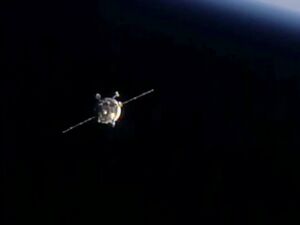Engineering:Progress M-29M
 The Progress M-29M has docked to the ISS just over six hours after launching. | |
| Mission type | International Space Station resupply |
|---|---|
| Operator | Roscosmos |
| COSPAR ID | 2015-055A |
| SATCAT no. | 40944 |
| Mission duration | 190 days |
| Spacecraft properties | |
| Spacecraft type | Progress-M s/n 429 |
| Manufacturer | RKK Energia |
| Launch mass | 7283 kg |
| Start of mission | |
| Launch date | 1 October 2015, 16:49:40 UTC |
| Rocket | Soyuz-U |
| Launch site | Baikonur, Site 1/5 |
| End of mission | |
| Disposal | Deorbited |
| Decay date | 08 April 2016, 13:31 UTC |
| Orbital parameters | |
| Reference system | Geocentric[1] |
| Regime | Low Earth |
| Perigee altitude | 193.77 km |
| Apogee altitude | 246.34 km |
| Inclination | 51.64° |
| Period | 89.42 minutes |
| Epoch | 1 October 2015 |
| Docking with ISS | |
| Docking port | Zvezda |
| Docking date | 1 October 2015, 22:52 UTC |
| Undocking date | 30 March 2016, 14:14 UTC |
| Time docked | 181 days |
| Cargo | |
| Mass | 2369 kg |
| Pressurised | 1549 kg |
| Fuel | 350 kg |
| Gaseous | 50 kg |
| Water | 420 kg |
Progress ISS Resupply | |
Progress M-29M (Russian: Прогресс М-29М), identified by NASA as Progress 61P was a Progress spaceflight by Roskosmos to resupply the International Space Station (ISS) in 2015. It was launched on 1 October 2015, to deliver cargo to the ISS. Progress M-29M is the final vehicle in Progress M-30M series, which was succeeded by the modified variant known as Progress-MS later in 2015.[2]
Launch
Progress M-29M was launched on 1 October 2015 at 16:49:40 UTC from the Baikonur Cosmodrome in Kazakhstan.
Docking
Progress M-29M docked with the Zvezda docking compartment on 1 October 2015 at 22:52 UTC. The spacecraft undocked from the station on 30 March 2016 at 14:14 UTC.
Cargo
The Progress M-29M spacecraft carried 2369 kg of cargo and supplies to the International Space Station. The spacecraft delivered food, fuel and supplies, including 350 kg of propellant, 50 kg of oxygen and air, 420 kg of water, and 1549 kg of spare parts, supplies and experiment hardware for the six members of the Expedition 45 crew. Progress M-29M is scheduled to remain docked to Zvezda for about two months.[3]
See also
- 2015 in spaceflight
References
- ↑ McDowell, Jonathan. "Launch Log". Jonathan's Space Page. http://planet4589.org/space/log/launchlog.txt.
- ↑ "Progress M-29M to supply ISS". www.russianspaceweb.com. 2015-09-29. http://www.russianspaceweb.com/progress-m29m.html.
- ↑ "Space Station Receives Express Delivery in Six Hours". NASA. 2015-10-01. https://blogs.nasa.gov/spacestation/2015/10/01/space-station-receives-new-delivery-in-just-six-hours/.
 This article incorporates text from this source, which is in the public domain.
This article incorporates text from this source, which is in the public domain.
External links
 |


